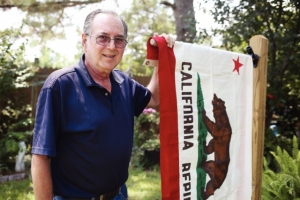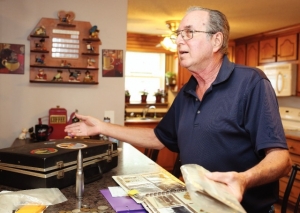California flying
By Steve Herring
Published in News on July 25, 2016 1:46 PM

News-Argus/CASEY MOZINGO
Roger Johnson stands beside the California state flag draped over a pole in the veterans garden at his Dudley home on Friday. The flag traveled with him around the world when he was in the Air Force and will soon be sent to a museum in California.

News-Argus/CASEY MOZINGO
Roger Johnson flips through some of the photos and keepsakes he has from his time serving in Vietnam.
Far from home on Cam Ranh Air Force Base in 1968, Dudley resident and then-crew chief Roger Johnson made a request.
A native of California, Johnson sent a letter to Ronald Reagan, then the governor of that state, asking him for a California flag to fly while on deployment.
"There were quite a few other fellows in our squadron who had requested state flags from their governors and received them," he said. "There were maybe six or seven of us from California, but no flag. So I decided I was going to send a letter to governor Reagan and try to get one for us."
Johnson wrote his request around three weeks after arriving in Vietnam. Though it took what Johnson called "an act of Congress," he got his wish. Reagan sent him his flag, with a personally signed letter, nearly a year after his arrival overseas.
"I am more than pleased to be able to meet your request for a California state flag for use in Vietnam, and I am sorry for whatever delay there may have been in getting this flag to you," the letter read. "I know you will fly it proudly."
Johnson, who worked as a mechanic on an F-4C fighter jet, sent the flag along with the pilots on their next mission to North Vietnam. Already the little piece of cloth had crossed an ocean, crossed a border and been to war.
Johnson said the flag's successful return was a cause for celebration.
"They flew it up north and brought it back, and we had a heck of a party," he said.
As part of the air component of the United States Central Command, then abbreviated as CENTAF and now as AFCENT, Johnson traveled across the world. He moved through Germany and Spain, Korea and Vietnam, even the Middle East. Before his eventual assignment to Seymour Johnson Air Force base, he was stationed at installations in California and Arizona. The flag went with him everywhere he went.
When Johnson came home, so did the flag. Not someone to let go of his things easily, Johnson added the flag to a growing collection of war memorabilia and other tokens from all over the world. Johnson gathered some kind of trinket everywhere the Air Force took him, from discontinued Australian money to old films of bombing runs and 20-millimeter bullets fired from aircraft in Vietnam.
These items have taken on a special value to Johnson. As he likes to say, he has "been there and done that," and has the souvenirs to prove it. The flag is accompanied by a host of coins and paper money, much of it no longer in circulation. One such bill even featured Saddam Hussein.
At one point, Johnson pulled a small, laminated piece of paper from the briefcase containing his collection. A small orange lump sat trapped underneath the plastic.
"That's dried napalm right there," he said. He placed it back in the briefcase, next to a picture of his Vietnam squadron and a bag of foreign coins.
To Johnson, the flag that he received so far away from his country had come to represent that very same land.
"Home. The flag represents home to me," he said. "It's sentimental, I just want people to know where it's been."
Johnson is now 69 years old, and his mind has turned toward leaving something behind when he is gone. Invariably, that notion is tied to his flag, the token that has been with him for most of his adult life.
While there were plenty of options for where to send the flag, Johnson eventually settled on bringing the flag's story full circle. He has decided to send it back to California, for use in the state museum there.
"The first thing they asked me was how much I wanted to charge for it," Johnson said. "I didn't want to change them anything, I just wanted them to have it."
Now, after over 40 years of travel and service, he will return the heirloom to its home.
